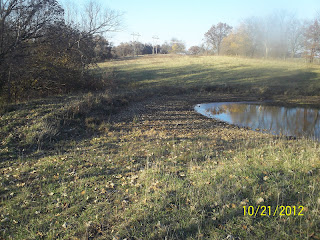Throughout harvest, Josh had been telling me all about how remarkably dry our ponds were. So Sunday afternoon, we took advantage of the beautiful Fall weather and took a Jeep ride in the back pastures to check them out. Here's a first hand view of the effects the drought has left us with so far:
 |
All of our ponds are used strictly as a water source for our cattle. So when the water dries up, it means that their water supply is gone. That leaves a farmer to have to water them via a waterer (a device where the water is continuously fed to the tank by an underground waterline and controlled with a float that "turns" the water off and on depending how full the tank is) or filling up a water tank manually (with a good ol' fashioned garden hose) everyday to give the herd adequate water.
In the picture, you can see that there is still some water in the center of this particular pond, but look at the amount of water left compared to the banks of the pond. You can see how very low this pond is! Keep in mind that all of these pictures were taken after we received nearly three and a half inches of rain. So while there are puddles in them, they were much lower before the rain came! |
 |
Again, there's some water left in this pond, too, but look at the banks... it should be much fuller!
We have multiple pastures in which a herd can be contained in at any given time. Each pasture needs a pond or creek as a water source, so we have an equal amount of ponds for the pastures we have. Thankfully, only one of our ponds completely dried up, which you'll see in a later picture. |
 |
| Look at the forefront of the picture and you can kind of make out where the water level is supposed to be on this pond. You can also kind of see a water level line on the right side of the picture, where the dam is. |
 |
| Here's a severely dried up pond, with only a puddle left in the middle. So dried up so that.... |
 |
| ....Josh and the kids drove the Jeep into it! If the water level were at where it should be, the Jeep should be completely submerged in the water save for about a foot across the very top! |
 |
| While most of the ponds still have big puddles in them, all of the creeks have completely dried up. COMPLETELY. For our ride, we were to go from one side of the pasture to the other, the sides being separated by a creek. Under normal circumstances, we would have had to go around. Not necessary this year though! We just drove down one bank, across the creek and up the other bank. |
 |
| A look at the parched creek bed. The water level should be covering the roots of the tree you see there. |
 |
| Look closely, you can see a cow standing on the right hand side of the picture. Not to be repetitive, but once again you can see where the water level should be and where it is sadly at. |
 |
| Yet another one. |
 |
| And the last pond on our trip. Before the rain, Josh said this pond was totally dried up; you could walk across it without stepping in a bit of mud. The puddle you see there is a complete result of the rain we'd gotten a few days before. |
These pictures may not mean too much to too many people, but they really are marking history! Old timers tell that they haven't seen things this dry since the 30's, and middle-agers' say they have NEVER seen it this dry! Many people in today's world do not realize the full impact that a drought has in the world around them, and a few dried up ponds aren't a big deal to them. However, think about it: livestock producers not only need ponds to keep their livestock alive, but also pastures to maintain their herd. The dry ponds can directly relate the amount of moisture available for pastures. How does this relate to you? Follow this logic: no pastures, no grass; no grass, no feed; no feed means an alternative feed source must be sought after; alternative source of feed means the livestock producer has to pay for it; having to pay for feed and water instead of using natural resources means a greater input cost to them and a greater demand for those feed sources; all that leads to farmers having to decide if their input costs can be made while breaking even in the end (we're not even talking profit during a drought year, just breaking even!). If farmers can't make costs break even, they sell out. Selling out their cows (the mamas) means herd sizes are diminished, resulting in fewer numbers of calves going to feed lots to be 'fed out', which are the tasty hamburgers, steaks and beef roasts you buy from your local butcher. Guess what less resources for meat means? That's right... eventually, a farmer's dried up pond is directly affecting YOU because you are paying sky high prices at the meat counter. And this is just one example among many. So a picture of a small puddle of a pond may not mean anything to most folks, but if they'll take time to think it completely through they'll see that it is cause of concern for us all!










No comments:
Post a Comment